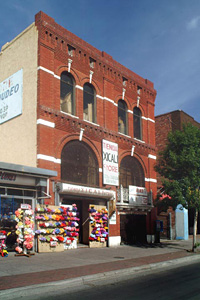
|  |  |  Entertainment | Books | January 2009 Entertainment | Books | January 2009  
El Paso Historian Fred Morales has Another Sensational Book
 Leon Metz - El Paso Times Leon Metz - El Paso Times
go to original


| | This Oregon Street building housed the El Paso Times in the 1890s and then became the Labor Temple and the printing press for the Labor Advocate newspaper from 1919 to 1962. (The El Paso Times/Labor Advocate) |  |
El Paso has been blessed by a long string of dedicated authors, both fiction and nonfiction, but one of the best and most prolific has been Fred Morales.

How many books this guy has written I don't know, although I suspect I have over two-thirds of them on my shelves.

But just a few weeks ago, I acquired a book from Fred that literally blew me away because of the incredible information it contains. The title is "History of the Union Plaza District."

And while that's not a ringing title in itself, the book is chock full of remarkable El Paso photos and even more remarkable El Paso history.

So what follows is a scattering of tidbits expressing the detail and the beauty of this book.

It opens by describing the area we call Downtown as once being known as Chivos Bravos, meaning "The Place of the Wild Goats," an area once a part of Mexico, but an area where back in 1820 the Rio Grande cut through and annexed this region to the United States.

In 1827, Ponce de Leσn purchased the land for 80 pesos, but in June of 1849, a freighter named Benjamin Franklin Coons bought the grant for $18,000. So what we now call Downtown El Paso was once Ponce's Rancho. Ponce built his ranchhouse where the Plaza Theatre stands today.

Years later, in 1885, the City Council passed an ordinance prohibiting bawdy houses within a triangle formed by El Paso and Santa Fe Streets ... and the Santa Fe Railroad tracks.

In 1889, the famous McGinty Club was born, a hill where City Hall now sits being known as McGinty Hill. From here the McGinty Cannon roared a few times each year to make sure the populace woke up early.

The nearby Hoy School started, the school being free and solely intended to prepare Mexican children to enter American public schools.

Sometime around 1916, a Spanish bullfighter nicknamed "Paquiro" after being gored 20 times and surviving, decided to move to El Paso. Here he became the father of the famous movie star Gilbert Roland.

In late 1913 into 1914, Francisco "Pancho" Villa purchased automobiles (yes, he loved automobiles), from the Chalmers Motor Co. at 205 Santa Fe Street, Pancho paying in gold.

In 1920, Mansour Farah opened a garment plant producing shirts. During that same year, an El Paso attorney named Michael Dolan -- who resided at 301 S. Chihuahua St., helped Pancho Villa arrange satisfactory surrender terms with the Mexican government.

That led to Villa being granted the Rancho Canutillo containing 25,000 acres in northern Durango state. Included in the deal were 50,000 pesos in gold and a guarantee of personal safety for Villa and his Dorados.

In 1923, the El Paso Chamber of Commerce launched a national publicity campaign to lure tourists to El Paso. The campaign slogan was "El Paso: Where Sunshine Spends the Winter." (Why would we drop a great slogan like that?)

If I had the room I could go on and on, but let me say that this book is soft-cover, spiral-bound, and has 80 pages of some of the most fascinating local history I've ever read.

This is a book every El Pasoan ought to own, be proud of and show off at family gatherings. It costs $40, is self-published, not available in stores, but will be hand-delivered by the author to your home or place of business. Call Fred Morales at 771-6727.

Leon Metz, an El Paso historian, writes often for the El Paso Times. Email: cmetz48888(at)aol.com |

 |
|  |



